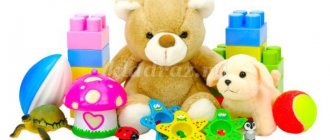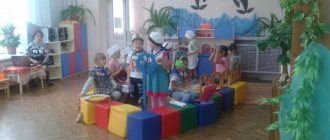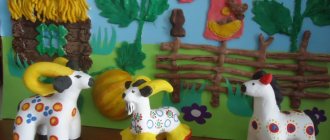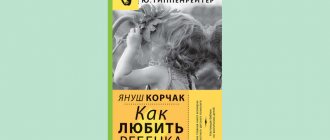General requirements for toys
Children in the younger group are very inquisitive and actively explore the world around them. They are interested in touching objects, examining them from all sides, breaking them and taking them apart. Many people do not miss the opportunity to taste the toy. Therefore, when arranging a garden, safety comes to the fore. Two- and three-year-olds do not always understand that something can harm them. Therefore, toys with small parts, sharp corners and loose elements are strictly prohibited. Make sure that the composition does not contain flammable or toxic materials. All parts should be easy to grip; there should be no splinters, burrs, or chips on the surface! “Talking” and musical games should not make too sharp or loud sounds. The maximum volume that is comfortable for a child’s ear is 70 dB.
What else you need to know about toys for younger preschoolers:
- They need to be selected taking into account the age characteristics of the children. If a child, due to his age, does not understand how to manipulate a complex toy (for example, a construction set with hundreds of parts or a controlled crane), then interest in it will quickly fade away.
- Toys should be multifunctional, broaden their horizons, and stimulate the child’s cognitive and research activity.
- They should evoke positive emotions, teach kindness and good deeds. No creepy monsters or characters with evil faces - this can provoke aggression, hysteria in children, and simply greatly frighten them.
Children spend most of the day in kindergarten. According to the Federal State Educational Standard, it is necessary to create for them a subject-spatial gaming environment that will not only be pure entertainment, but will also give an idea of the real world. Place your bets on popular self-learning toys. In the process of interaction, children intuitively understand how to handle them correctly. Such toys include aids based on the Montessori school method: sorters, lacing, busy boards, insert frames, wooden puzzles, boards, sensory bags, tactile books, etc. They help to learn about the main properties of surrounding objects (shape, size, color, texture), train logic, concentration and fine motor skills.
Provide easy access to toys in the playroom. They should be located in containers, boxes or on shelves at the height of children. For games with many small parts, consider packaging that closes tightly and securely.
Consultation for parents “What toys do children of older preschool age need”
Lyubov Misheneva
Consultation for parents “What toys do children of older preschool age need”
Nowadays, the choice of toys for children is so diverse and interesting that for every parent interested in the development of their child, the question involuntarily arises: “Which toy to choose ?”
.
But, let's first define what a toy ? Toy , an item intended for children's games. By recreating imaginary and real objects and images, the toy serves the purposes of mental, moral, aesthetic and physical education. The toy helps the child learn about the world around him, promotes the development of thinking, memory, speech, emotions, and accustoms him to purposeful, meaningful activities. In order for a child’s development to be harmonious and complete, children must play!
What games are important for a child of senior preschool age .
Games for older preschool can have a variety of themes. But when choosing them, you need to remember:
• To maintain children's interest, the rules of the game must be accessible and aimed at winning. Only success in gaming activities can make you want to return to it again to continue. Subsequently, tasks can be made more difficult.
• An adult playing with children must evaluate each child's activity. The assessment should be positive in most cases. After all, praise gives rise to the desire to win, and censure and criticism entail reciprocal passivity. A 5-year-old child may already be fully aware of his mistakes, which an adult can correctly point out, but at the same time be sure to suggest a way to improve the result.
• Parents and adults surrounding preschoolers need to remember that a child at this age must play enough so that, as an adult, he does not “play too much of childhood”
, striking others with infantile decisions and actions.
The best toys for children of older preschool age are considered to be different types of construction sets (fabric, soft, metal, wood, plastic)
stencils and diagrams for
design that develop creativity and spatial thinking.
These are building materials and play sets of small, medium and large sizes (bricks, bars, cubes, bolts, screws, nuts and tools for tightening them. Visual and figurative thinking, fine motor skills, imagination, creativity, attention and accuracy, help develop activities such as modeling, modeling, drawing, designing from natural and waste materials.
Story-based role-playing games give the child the opportunity to learn and learn social norms of behavior. Children enjoy playing at the hospital, cafe, hairdresser, shop, school, library, daughters and mothers. Accordingly, they need equipment and attributes for these games. This is a set of a hairdresser, a doctor, a certain amount of dishes, dolls and sets of small and medium-sized doll furniture (bedroom, dining room, kitchen, living room)
;
sets of clothes and shoes, a set of linen for a baby doll; instruments and instruments (binoculars, steering wheel, mailbox, anchor, etc.)
;
items of clothing that reflect the role (robes, caps, caps, helmets)
;
household items (bags, wallets, baskets, brushes, sewing kits)
. carnival masks, attributes of fairy tale costumes.
You can use old mechanical alarm clocks, cameras, etc. as educational toys “practical mechanics.”
. This disassembly and assembly stimulates thinking and develops fine motor skills.
To develop logical thinking, a child needs games that allow him to establish the sequence of events and cause-and-effect relationships. These can be various board games and puzzles (mosaics, checkers, chess, game sets with the “Fourth wheel”
,
“Place in order”
, dominoes
“Transport”
,
“Geometric shapes”
, lotto
“Who Lives Where”
,
“Zoological Lotto”
, games with cubes and chips,
“Columbus Egg”
,
“Tangram”
,
“Unicube”
, puzzles. )
Much attention should be paid to the motor activity of children on the street. For a walk you can take: a bicycle, a scooter, roller skates, balls, boomerangs, rackets with shuttlecocks, etc.
When organizing outdoor games with children, you need to consider:
• By the age of 5, children's muscle mass , performance and strength increase. However, many children are not yet capable of prolonged physical stress and significant physical activity. Therefore, outdoor games for children 5 years old should last no more than 15 minutes so that children do not get tired.
• When explaining the rules of playing with an object, for example with a ball or a jump rope, we should not forget that preschoolers have predominantly imaginative thinking and very little motor experience. Therefore, an explanation of the rules of the game is always accompanied by a demonstration.
A 5-year-old child experiences a great need to understand the world around him and expand his horizons. He, like a sponge, absorbs all cognitive information. It has been scientifically proven that at this age a child is able to remember as much material as he will never remember later in life. Children 5-6 years old are interested in everything related to the world around them. Therefore, it is important to carefully select games and toys for your child .
One piece of advice. Don't take your child too often to a toy store with lots of tempting but very expensive toys . How many tears and sufferings of the kids saw the newfangled dolls, cars and animals sitting on the counters! These experiences, when a child cannot get what he really wants, he does not need . Only when you yourself are ready to give your child joy, take him to the store and make him a holiday.
What are the toys made of?
Let's look at the main materials from which children's toys are made for junior groups 1 and 2.
- Plastic. Typically this is polyvinyl chloride, polypropylene or polystyrene. A huge number of toys are made from plastic: cars, construction sets, cubes, sets of dishes, pyramids, sandbox accessories, vegetables and fruits, etc. Plastic has a rich color scheme, and the toys themselves are bright, often interactive and multifunctional. Plastic products are produced in Russia and in huge quantities in China. You need to be especially careful with Chinese-made toys, because plastic often contains components that are harmful to health: phthalates, phenols, heavy metals. When purchasing plastic toys for children in a kindergarten, be sure to check whether they comply with the requirements of GOST and SanPin. Such toys have a quality certificate and are marked “does not contain phenols or phthalates.” You can recognize a “harmful” toy by its pungent chemical smell, paint that stains your hands, or plastic burrs along the edges.
- Tree. For the production of games, species that can be easily processed are used: birch, beech, pine, etc. They are environmentally friendly and do not harm the child or the environment. Among the wooden toys there are many educational aids, puzzles, construction sets, puzzles - everything that develops motor skills and tactile sensations. Wood is heavier than plastic. By touching it, the child understands the real weight of the object: it takes some effort to lift and move the wooden figurine. Laconic toys that are not overloaded with details awaken the imagination and provide unlimited scope for imagination. If the toy is not painted, you can paint it together with the teacher or leave it in its natural form to see a cut of a real tree with growth rings and veins.
- Textile. Soft toys, puppet theater characters, cubes, and educational felt books are made from it. Fabric dolls must have a solid frame so that the body does not deform or bend during play. In a soft stuffed toy, the seams must be strong and neatly stitched so that the filler does not come out. Sharp objects, glass, cotton wool, and granules with a diameter of less than 3 mm are not allowed as filler.
Most toys combine different materials. For example, a bodyboard on a wooden base usually has metal locks and latches, plastic beads, fabric characters, laces, and zippers. Such a variety of textures, rough and smooth surfaces perfectly develop sensory experience, sharpen the accuracy and coordination of hands and fingers.
From 2 to 3 years
Older babies love to explore their physical skills, so offer them toys that challenge them to jump, climb and throw. This age group has good hand-eye coordination and enjoys using their fine motor skills to work with basic creative activities (drawing, sculpting, appliqué), playing with dolls, blocks and simple puzzles. Choose toys that develop imagination.
Balls and balls Building blocks and construction systems Blocks and cubes with letters and numbers Puzzles with pieces with handles (whole objects that fit into simple scenes) Insert frames Dolls that can be bathed, fed Clothes and accessories, carnival costumes for role-playing games Gloves dolls Play scenes (e.g. farm, airport, zoo) with figures and accessories Sandbox toys Tricycle and helmet Runbike Toy vehicles Trailers Sorters Theater Soft toys
Baby Born dolls. Among them are the first soft dolls for babies (from 1 year).
Toys for speech development in the younger group
From the age of 2, the child begins to enrich his active vocabulary, construct phrases, and attempt meaningful dialogue. Therefore, you need to pay attention to games for fine motor skills and manipulation of objects. Speech and motor skills are inextricably linked: the brain centers responsible for speech are located near the motor area. The best stimulants for speech development will be:
- sorters, labyrinths, lacing beads - train the accuracy of actions;
- business boards based on cartoons or fairy tales - develop imagination, imagination, teach how to play out scenes and at the same time interact with elements (open and close windows, rearrange a character in a train, etc.);
- musical toys: metallophones, xylophones - develop coordination, teach you to distinguish sounds, feel the rhythm, encourage you to hum a melody;
- folk toy matryoshka - introduces children to Russian folklore, promotes speech development with the help of riddles, counting rhymes, and nursery rhymes;
- cards with images of animals, objects, phenomena - each card can be examined and discussed what is depicted.
During the game, the teacher needs to talk through all the actions with the children, imitate the sounds of animals, speak slowly and clearly, and pronounce each sound. Kids like to repeat everything after adults, so they will happily pick up phrases and become participants in the “dialogue.”
List of toys for 1st junior group
Junior group 1 includes children from 2 to 3 years old. They are often restless and very active. Therefore, they need a constant change of activities so that active games alternate with “developmental games” that require concentration and perseverance. Wooden toys are a priority here: they are safe, understandable, and contribute to the development of imagination and creativity.
We have selected 10 toys that a group of little ones definitely cannot do without.
- Busy boards, especially thematic ones, based on fairy tales. Objects united by one theme are collected on one surface. This will allow children not only to develop tactile skills, but also to use their imagination, come up with scenes and stories with characters on the board.
- Wheelchairs - hone your sense of equilibrium and balance.
- Toys for stringing parts, tying or screwing: sorters with pins, pyramids, lacing.
- Large cubes with numbers and letters are the first steps to understanding mathematics and writing.
- Puzzles where you need to assemble a whole picture from 4-5 pieces.
- Insert frames with images of animals, transport, fruits, vegetables, etc.
- Simple wooden construction sets with 25-30 parts.
- Labyrinths with several challenging bead routes.
- Cut-out pictures and educational cards depicting letters, cars, fruits, vegetables, and various household items. In this case, the child compares the visual image in the picture with the spoken word. Having remembered, in the future he can easily say the name of this or that object.
- Balls, ring throws, sandbox sets, etc. everything for outdoor games.
During the lesson with toys, the first younger group only begins to engage in productive activities: drawing, design, attempts at story-based play. It is important for a kindergarten teacher to support these endeavors, take an active part in the game, and comment on the actions.
List of toys for 2nd younger group
The 2nd younger group includes children from 3 to 4 years old. Fine motor games are still important for them, but role play also appears in the activity. This is where toys come in handy, with the help of which kids come up with various scenarios and simulate real-life situations. Children learn to play together and show creativity. Therefore, to the previous list of materials for the first group we will add a few more:
- Calendar games on a wooden base. They are similar to busy boards, but their purpose is to teach the child to determine the time, day of the week, season. These manuals are bright and colorful, the numbers on the dial are clear, and the weather and season are indicated with a caption and pictures to make them easier to remember.
- Role-playing games on various topics: doctor’s and hairdresser’s kits, grocery baskets, household appliances, dishes. Girls like dolls and doll houses, boys like robots and fantastic animals.
- Lotto and dominoes. Promote the development of speech, memory and logical thinking. They are convenient to play with a whole group, but only under the supervision of a teacher.
- Various types of public transport and cars.
- Finger theater, hand puppets and folding theater screen.
Games that deepen knowledge about counting will be useful: business boards with numbers, abacus, counting sticks, fraction puzzles. Construction sets for the second junior group of kindergarten are much more complex; they contain more details and small elements.
Play equipment in the garden needs to be changed and updated regularly. Over time, any toys become outdated, worn out and simply boring. But competently equipping a kindergarten is only half of success and harmonious development. For young children, the most important thing is to introduce a new toy correctly. Try to clearly explain and clearly show how it should be handled. And most importantly, do not forget about safety rules and age-appropriate toys
From 3 to 6 years
Children begin to actively play with each other. At this age, preschoolers may be heading off to daycare, so toys that encourage imaginative and collaborative play are great for this age group. Experiments are also popular, since children at this age practically explore the world.
Tricycle / bicycle / balance bike and helmet Scooter, skateboard Construction sets Laces and beads for stringing Puzzles (10-20 pieces) Soft toys Dolls and clothes for dolls Clothes for dressing up Props for role-playing games Toys to ride on Bouncing balls which you can jump while sitting Glove puppets Non-toxic materials for creativity (scissors, colored paper, crayons) Simple board games Cards on various topics Puzzles for this age
Set of wooden high-rise buildings. You can plant trees wherever you want. Drive your own car. And at night the city comes alive and the lights flicker in the windows! Set from Wonderworld.
At this age, children try on different roles, hence games of daughter-mother, war game, doctor, hairdresser, etc. Toys for joint role-playing games are perfect: strollers, sets of professions, construction sets, soft toys, dolls, toys with control. All this, as well as much more for children of any age, can be purchased at the only sunny Bubl-Gum hypermarkets in Russia. “Buble-Gum” are children's hypermarkets with an unusual bright design, logical layout of goods, easy navigation and special soft lighting, close to natural in spectrum. That is why “Buble-Gum” is called “sunny”.
The children's hypermarket "Buble-Gum" has direct contracts with hundreds of manufacturers of children's goods, toys and food. As well as our own mid-budget brands of clothing and toys, the production of which undergoes the strictest quality control from the manufacturer’s conveyor to the store shelf. In addition, clothes, shoes and toys from Bubblegum are made in exactly the same factories and using the same materials as expensive “brand” products (like Hasbro, Zapf Creation, Spin Master, etc.). But in the case of things and toys from Bubl-Gum, you won’t have to overpay for brand promotion. And Lanson Kids clothing (its own brand “Buble-Guma”) retains its color and shape even after 50-100 washes! Whereas similar items from other brands with the same price tag lose their presentation after the first wash.






